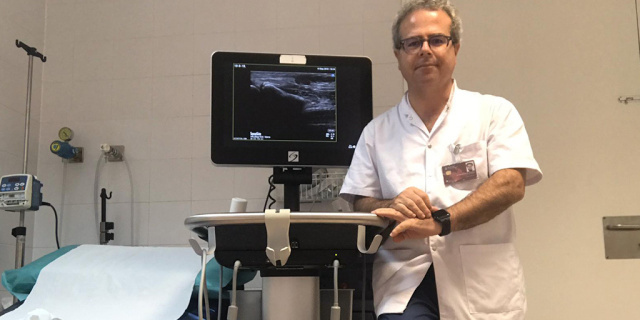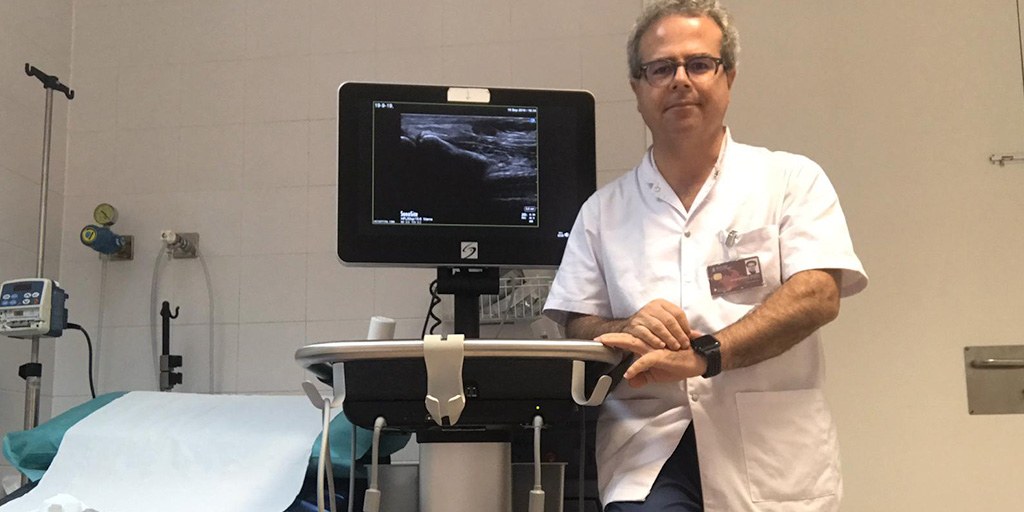

Point-of-care ultrasound (POCUS) has a significant role to play in pain management for patients around the world. Dr. Victor Mayoral Rojals, Consultant Anaesthetist and head of the pain unit at the Bellvitge University Hospital, in Barcelona, Spain, discusses the many advantages of ultrasound in his day-to-day practise.
My early experiences of using point-of-care ultrasound in pain management began in 2005, when I worked together with Dr. Xavier Sala-Blanch—a pioneer for using ultrasound in anaesthesia—to organise the first congress of the Catalan Society of Anaesthesia. He demonstrated the brachial plexus approach for the first time. I immediately realised the possibilities offered by ultrasound as an aid to the different infiltration and radiofrequency techniques that we had been using in the pain unit, compared to other imageing modalities or only anatomical references.
Advances in medical imageing have opened up even more possibilities to the way that POCUS can be used. For the last eight years, we have implemented the use of ultrasound for the treatment of oncology pain at the Institute Català d'Oncologia (ICO), where I work two days a week. We use it as a substitute for other imageing techniques in more than half of the patients.
Finding the Root of Pain
In all cases, whether we are looking at a patient with nociceptive or neuropathic pain, it is the precision, speed, and dynamism of POCUS that we really appreciate. We often start with a good idea of what structure is causing a patient’s pain. Based on this, we use ultrasound and other imageing techniques—X-ray, CT, magnetic resonance, nuclear medicine techniques, etc.—to study that structure, sometimes at a neurophysiological level if we believe there is a neuropathic component.
In oncology, ultrasound is particularly useful since the anatomy is clearly altered by tumour growth and may have changed since the last MRI scan. Knowledge of sectional anatomical and innervation of invasive tumours and their metastases is essential. We can treat these nervous structures with different drugs and techniques, often guided only by ultrasound or sometimes by a combination of ultrasound and X-ray techniques.
X-rays show us bones where the nerve might pass through, but we can’t clearly see the nerve or the tumour. MRI shows us everything, but with static images and only the big trunk nerves are clearly visible. Ultrasound gives us clear images of everything in motion.
Targeted Therapy
Once the cause of pain has been identified, we then decide whether a patient is a candidate for an interventional procedure. We frequently use a range of techniques and with good success, from simple cortisone injections and local anaesthetics, to a platelet rich plasma infiltration and neuromodulation procedures, such as radiofrequency and neuro-stimulators. Before POCUS was established, many of these techniques, especially those performed on nerves, were performed with the help of X-rays and nerve stimulators. It was a slower, more expensive technique with all the disadvantages of using ionising radiation. Now we rely on POCUS, which is a much more sensible and practical approach. It gives us good image quality for needle guidance, and many automated processes that help to make the whole procedure fast and accurate.
From a Strong Heritage to an Exciting Future
I have used FUJIFILM Sonosite systems since 2007 and like them because they are handy devices that have clear interfaces and are quick to boot up. Their portability also means that they can be easily and efficiently moved from one point of patient care to another if necessary. The company itself has been at the forefront of POCUS from the start. Sonosite has a strong commitment to training and we are very grateful for the support it has given us over the years.
Our Sonosite systems have really made a difference to how quickly and easily we can perform scans and recognise critical structures in the body; the convenience of POCUS can have a significant impact on patient care. It is an excellent, non-invasive technique that gives doctors who treat chronic pain confidence and peace of mind in diagnosis and needle guidance.

